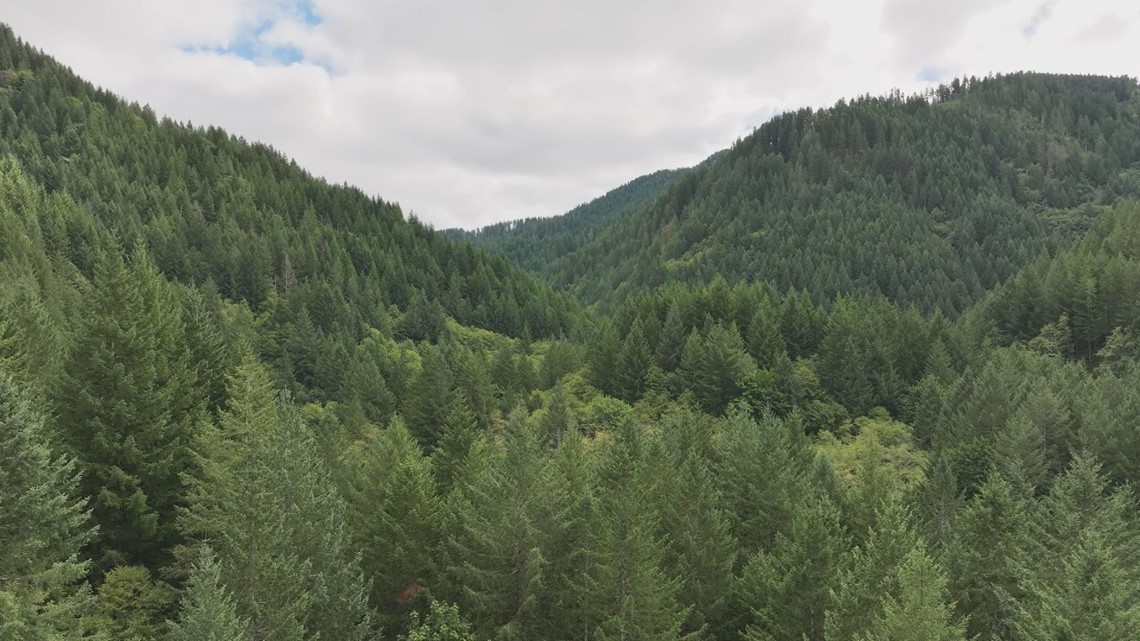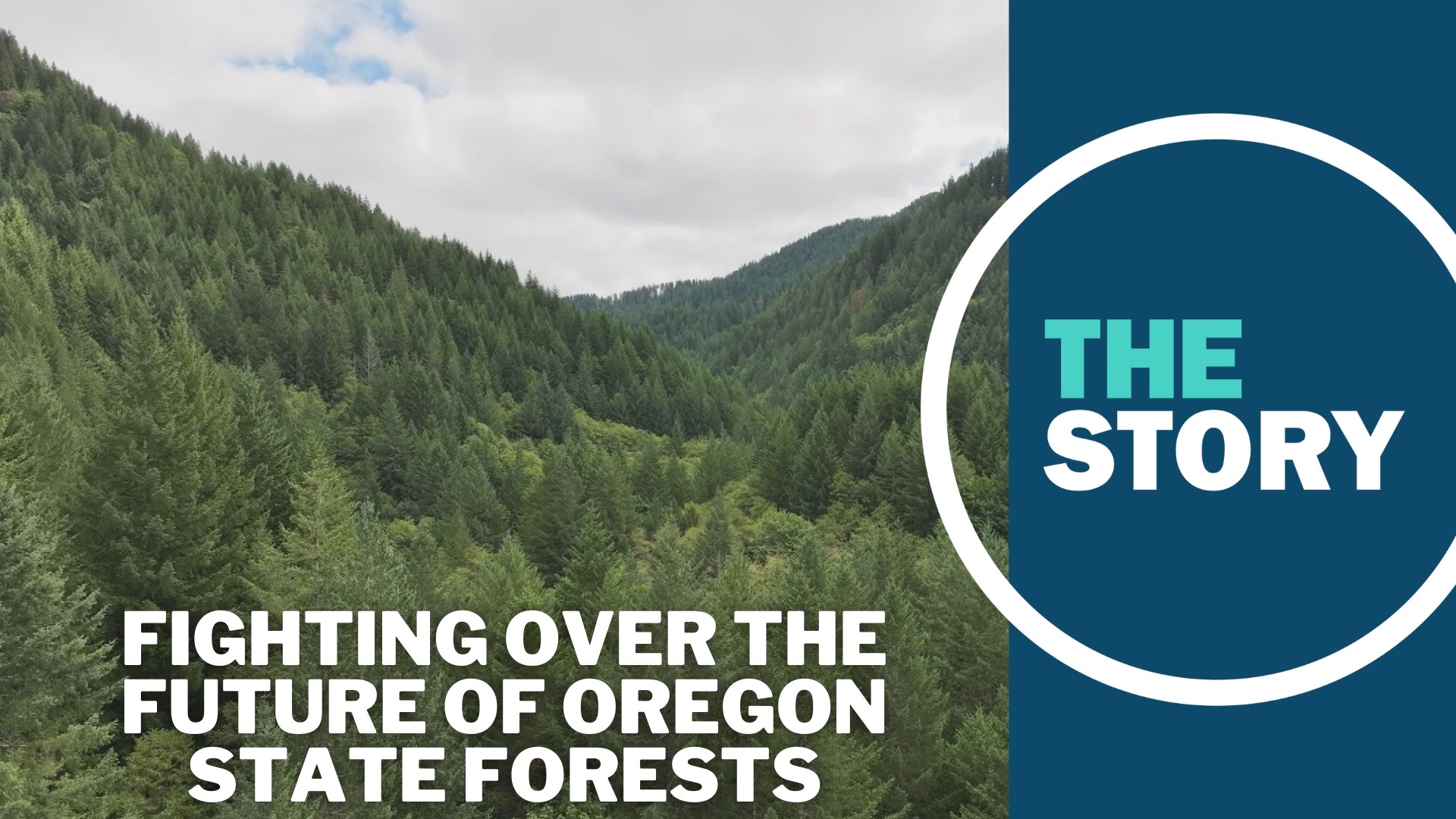GALES CREEK, Ore. —
Oregon’s state forests signify different things to different people.
For timber companies, they are a resource that provides jobs in rural areas where full-time positions with benefits are hard to come by.
For environmentalists, they are habitat for endangered species, important places that store carbon — wilderness best left untouched.
For the counties that are home to large state forests, they are revenue sources, helping to fund crucial services like sheriff’s offices, schools and 911 call centers.
So as the Oregon Board of Forestry seeks to craft a Habitat Conservation Plan for the roughly 700,000 acres of state forest — mostly in Tillamook and Clatsop counties — Chair Jim Kelly has had to get comfortable making people unhappy.
“Our job is public policy. We're supposed to balance all these things using the best available science to make the hard decisions,” Kelly said. “No one's going to be particularly happy but that's what compromise is all about.”
For years, the Oregon Department of Forestry has seen lawsuits pop up over parcels it sells for logging. Often, the suits allege the sales are illegal under the Endangered Species Act, which restricts the destruction of habitat for animals like the northern spotted owl, the marbled murrelet, red tree voles and Oregon Coast coho salmon, all of which can be found in state forests.
Those lawsuits can prove disruptive and costly, so the state began crafting a Habitat Conservation Plan in 2018. The plan, if approved, would set aside certain parts of state forests for conservation, creating areas where no timber harvest could occur.
If approved by federal agencies that oversee Endangered Species Act protections — the National Oceanic and Atmospheric Administration and the U.S. Fish and Wildlife Service — the Habitat Conservation Plan would protect the state from lawsuits while allowing timber companies to harvest from the remaining land.


Debates about the plan have fallen along predictable lines, with conservation groups arguing for more land set aside and timber interests claiming the plan is far too restrictive. But the stakes with the plan are higher than usual: It will set policy in state forests for the next 70 years.
Tillamook County Commissioner David Yamamoto is among those who worry that the plan, as it’s currently drafted, will wreak havoc on his county’s finances.
“We do object strenuously to the way this particular habitat conservation plan was developed,” Yamamoto said. “Tillamook County is one of the larger recipients of timber revenue and almost 25% of our general fund budget comes from timber harvest.”
If you want to know how Tillamook County became so reliant on timber revenue, you have to go all the way back to the 1930s.
The Tillamook Burn
On Aug. 14, 1933, a massive blaze broke out in a logging camp on what is now the Tillamook State Forest. With temperatures above 100 degrees and the fire burning in a remote part of the forest, it spread quickly, burning 40,000 acres within the first 10 days.
Then, on Aug. 24, strong winds blew in and the blaze exploded to roughly 240,000 acres, burning well into September of that year.
But that fire primed the landscape for additional burns, with new fires popping up every six years until 1951. All told, the blazes consumed roughly 355,000 acres of private forest land in the Coast Range.
In the aftermath, many private owners failed to pay taxes on land that was no longer producing any revenue. Soon, much of the land would be turned over to the state, forming what is now the Tillamook State Forest.
But the land came with a catch: Revenue from timber harvesting on the land would be split, with two thirds going to the county and the other third going to fund the Oregon Department of Forestry.
Under this agreement, the state pledged to manage the land for “greatest permanent value” by providing “healthy, productive, and sustainable forest ecosystems that over time and across the landscape provide a full range of social, economic, and environmental benefit to the people of Oregon.“
There has been much debate in the intervening years over just what the greatest permanent value of Oregon’s forest should be.
Several counties sued the state in a case decided in 2019, arguing the greatest permanent value agreement meant that state forests should be managed for maximum timber profit. Initially, a judge ruled in favor of the counties, awarding them more than $1 billion in damages — but the decision was overturned by an appeals court judge and the Oregon Supreme Court declined to hear the case.
Environmental concerns
Casey Kulla, state forest policy coordinator with Oregon Wild, said the current draft of the plan still has some problematic areas that would be available for timber harvest. Specifically, he has advocated for a connected wildlife corridor that would run north-south along the crest of the Coast Range.
“Having a connection from the Columbia River all the way down the Coast Range, on the backbone of the Coast Range, will be so important for the continued persistence and expansion of critters habitat,” he said. “In 70 years, we're going to need habitat for all kinds of critters here, especially with climate change.”
Kulla argues that state forests belong to all Oregonians and that the history of logging in the area has been detrimental to many of the species that now need protection.
“If we think about this as an investment that we all own together and manage together, we've used it for profit more than we should and animals are suffering because of it.”
Kulla, who is a former Yamhill County Commissioner, said that he’s familiar with Yamamoto’s concerns and they aren’t entirely misplaced.
“Commissioner Yamamoto cares deeply about this place. And like him, I understand how county budgets work,” Kulla said. “I know other money can be found to replace that revenue because we don't have another Oregon State Forest.”
A spokeswoman for Gov. Tina Kotek said the governor supports the work of the Board of Forestry in crafting a plan that is fair to all sides.
“She understands that this balance will likely result in diminished harvest revenue to some counties, and she has committed to working with impacted counties to identify alternative sources of revenue to lessen their dependence upon harvest of trees on these publicly owned forests,” the governor’s office said in a statement.
How much the timber harvest will diminish remains to be seen.
‘Drastic’ cuts to logging
Chris Edwards, president of the Oregon Forest Industries Council, said the current plan would pose a very real threat to the livelihoods of the people who work in the timber industry.
“Without a doubt, our biggest concerns with the HCP as it stands currently is the drastic reduction in timber harvest,” Edwards said. "It's certainly going to cost hundreds of jobs. At a time when you’re really decimating the job base, you’re also increasing the dependency on critical social services and you’re also undercutting the source of funding for those social services.”
Between 2010 and 2020, the lands that would be covered under the plan saw an average yearly output of 285 million board feet of timber. Early estimates for the Habitat Conservation Plan predicted that number would fall to around 225 million board feet if the plan was implemented.
“Those were drops in timber harvest, but honestly we felt that that was a number we could live with,” Yamamoto said.
More recent estimates have dropped even lower, though. New figures indicate that total yearly timber output would fall to between 165 and 185 million board feet, a drop of between 30 and 40% from the yearly average last decade.
“You don't need to reduce timber harvest by 34% to put in place sensible protections for wildlife,” Edwards said. “It goes too far and we'd like to see a little bit more balance to the plan.”
Kelly, the chair of the Board of Forestry, conceded that the reductions were higher than expected.
“We expected that there would be significant reduction in harvest levels in the neighborhood of probably 15%,” he said. “Then eventually when the models came out, those levels were probably more in the likely range of 25 to 30 or 35%.”


Last week, Kelly introduced a resolution to shift some of the areas that would be conserved to allow for a slight increase in harvestable timber, while keeping the total acres of protected areas the same.
Yamamoto said the resolution has put him in an uncomfortable position.
“It's difficult for us to object to an increase in timber revenue, but 5 million more board feet annually? That is inconsequential, absolutely inconsequential,” he said. “We don't want to be in a position where the department nor the Board of Forestry think that because of this proposed resolution that we are now in full support of the Habitat Conservation Plan.”
Kulla has his own concerns.
“Every time we bring in ideas to weaken it, we take it further from a compromise and more to logging as usual on public land,” he said.
If the resolution passes, the changes would be made by Board of Forestry staff behind closed doors with no public hearings, which Kelly argued wouldn’t be necessary since the changes to the plan would be relatively minor.
And that prospect is one thing that Kulla, Edwards and Yamamoto have common ground on. All three said they want the process to be as transparent as possible.
“They're just trying to get this off their plate as quickly as possible because it's a political hot potato for them,” Edwards said.
If the resolution fails on Thursday, the plan would be forwarded to the National Oceanic and Atmospheric Administration and the U.S. Forest Service for review. If the federal agencies approve, the plan could be implemented as soon as early 2024.
If the resolution passes, staff would need time to implement the changes, which could push approval back further into next year.
Kelly is well aware that the plan has its detractors, but he pledged to continue listening to people on both sides of the issue.
“You have all these people making heartfelt testimony about what this means for their family logging company, what this means for their community, what this means for the school. And then you've got equally passionate people equally right around many of the issues relative to conservation,” Kelly said. “We're not going to make anybody happy, but we're trying to find a path forward that is the best for all concerned.”

